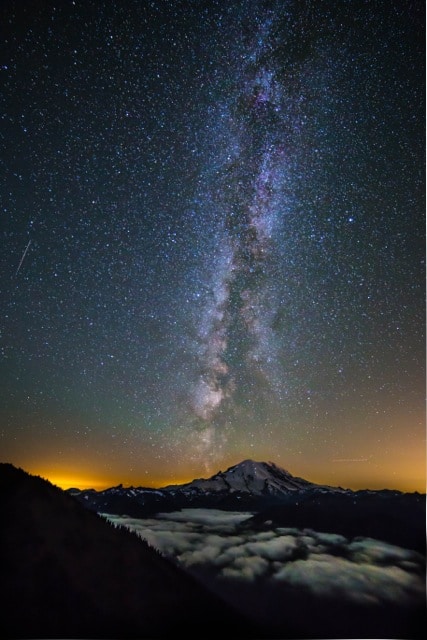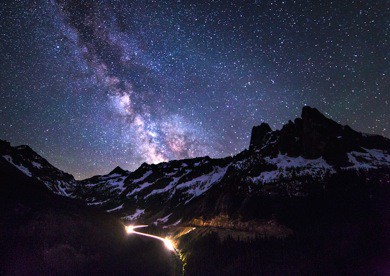Starstruck: One Grad's Perspective on the Night Sky

by Lauren Ridder, M.Ed. Graduate Student
There are only a couple of things that can stop me in my tracks. When clouds part to reveal a night sky full of stars, my gaze is irresistibly drawn upwards, and I feel my perspective shift. My breathing slows and my awareness sharpens, as my mind races far away from the Earth’s surface to find those familiar patterns in the sky.
What I love about constellations is that I could be anywhere in the world, feeling lost and overwhelmed by the chaos of everyday life, but as soon as I spot those sparkling forms high above my head, I feel re-oriented. It feels like an ancient connection to not only centuries of human folklore, but also to pages in stars’ life stories that are long gone as their light travels through all the layers of time and space to reach Earth.
I have several favorite constellations to search for including: Orion, Delphinus, Cygnus, and Andromeda. Orion is the first constellation that I can remember identifying on my own, and I’ve loved tracing its path across many night skies throughout my life. As a winter constellation, Orion appears in the Northern Hemisphere in late November. Orion is usually portrayed as the Great Hunter charging across the sky with shield in one hand and sword in the other. Another more seasonally linked version of the story comes from the Ojibwe people who name this star group, Biboonkeonini the Wintermaker. The prominence of the three stars that make up Orion’s Belt leads to this constellation’s familiarity across cultures. Alnitak, the leftmost star in the Belt, means “the girdle” in Arabic; Alnilam in the middle, translates as “string of pearls”; and Mintaka, on the right, means “the belt”. On March 6 of this year, Orion was due south, standing upright at his highest.
The two most recent additions to my constellation library, Cygnus and Delphinus, are located near each other in the northern early summer and mid-autumn skies. Cygnus swims along the Milky Way with Delphinus leaping out near the swan’s left wing. Cygnus is easy to spot on a clear night with the bright star, Deneb, marking the swan’s tail, and four other prominent stars within its body that form a grouping also known as the Northern Cross. Delphinus is harder to pick out and requires a softening of the gaze and a little patience. Once the little Dolphin makes itself known though, it’s hard to forget.
Andromeda is one of my favorite constellations because it contains the closest spiral galaxy to us, Messier 31 (M31) a.k.a. the Andromeda Galaxy. M31 is one of the most distant objects visible to the naked eye at about 2.2 million light-years from Earth. Since Andromeda the constellation is located so far out of the galactic plane of our Milky Way galaxy’s bands, dust and stars don’t obscure the view of M31 and the many other galaxies contained within Andromeda’s boundaries. Andromeda is visible in the fall and early winter, though only from north of the 40° south latitude. The constellation has a rich story originating in Greek legend. Andromeda, known as “the Chained Woman” was the daughter of Queen Cassiopeia. Cassiopeia bragged to all who would listen that her daughter was the most beautiful woman in the world, more beautiful than even the Nereids, the sea nymphs. The nymphs did not appreciate this, and demanded that Poseidon punish Cassiopeia by sending the Kraken, a sea monster, to attack Cassiopeia’s kingdom. An oracle informed the royal family that the only way to save the kingdom was to sacrifice the Princess Andromeda. Andromeda was thus chained to a rock by the sea as an offering to the Kraken, but was thankfully saved by the hero Perseus, who used the head of Medusa to turn the monster into stone. That’s a whole other story, but one that lives on forever in the stars. The constellations of Cassiopeia, Perseus, and his winged horse, Pegasus, can all be found near each other in the sky.
Usually when seeking out these constellations, my eyes are drawn towards the bright, unwavering beacons of the planets as well. The clear winter nights in North Cascades National Park have held almost all visible planets with Venus and Mars early in the evening in the west, Saturn (look south) and Mercury (look east-southeast) appearing near sunrise, and Jupiter shining high and bright throughout the night in the east. Uranus is visible in the background of Venus just after dark, while Neptune is hidden in the glare of the Sun.
These constellations, planets, and galaxies are a huge part of my sense of place. I see the twinkling of these stars as their light passes through all time and space and instantly feel centered and at home in the universe.
And then a satellite crosses my line of vision, my mind snaps back into our atmosphere, and I continue my walk home, taking a piece of the stars’ story with me.
*All photos by Andy Porter. You can see more of his work here.


